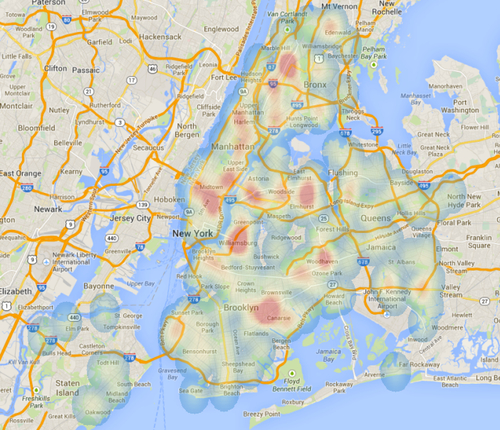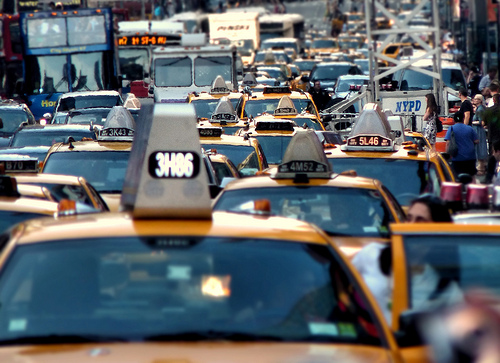Charting traffic fatalities: New York’s deadliest neighborhoods
A Pratt University statistics professor has used 2013 data on crashes and fatalities to map out New York City’s most traffic-dangerous neighborhoods. The heat map highlights challenges faced by the city’s new Vision Zero Action Plan, which aims to reduce traffic fatalities to zero in a city especially troubled by traffic-related injury and death.

This heat map shows New York’s most dangerous neighborhoods. From streetsblog.org.
According to StreetsBlog, Professor Ben Wellington, who teaches city planning students in addition to creating maps based on New York City data for his blog, I Quant NY, drew on information culled by volunteers in the Crash Data Band-Aid project (the latest traffic crash information in an easier-to-use format than provided by the NYPD) to map out last year’s traffic deaths and cyclist injuries.
Working with city-defined neighborhood bounds, Wellington discovered that a staggering 23 percent of all traffic deaths took place in only five percent of New York City’s neighborhoods, although general fatalities were distributed throughout the city. Despite this high concentration, the majority of traffic deaths happen outside of these neighborhoods. Last year, 60% of traffic deaths occurred in neighborhoods “with at most two fatalities,” notes Wellington.
New York City has a deadly traffic problem. According to the mayor’s office, about 4,000 New Yorkers are seriously injured — and more than 250 are killed — in crashes yearly. Getting hit by a car is the top cause of injury-related death for kids under age 14. It’s the second-leading cause for seniors.
Yet streets are becoming safer, with traffic fatalities dropping from 701 in 1990 to 249, the lowest in city history, in 2011. New York City Mayor Bill de Blasio’s Vision Zero Action plan aims to reduce traffic deaths to zero by using set of 60-plus initiatives, such as reducing the city speed limit from 30 to 25 mph and installing more speed and red-light cameras.

From joiseyshowaa.
Wellington’s heat map reveals a number of challenges faced by the plan, including a few of the city’s most notoriously dangerous streets: Queens Boulevard, long known among locals as “The Boulevard of Death”; Broadway in Williamsburg, Brooklyn; and Grand Concourse, a major plaza in the Bronx which hosted three deaths on three consecutive streets within the year, are all highlighted.
As for cyclist injuries, last year saw more than 3,800 reported injuries. The highest concentrations were charted in Williamsburg and Clinton Hill, both in Brooklyn; Jackson Heights, Queens; and Manhattan, below 59th Street. According to Wellington, these areas may not be the most dangerous places for bikers; instead, the areas may be places where the most people are riding bikes.
Wellington’s map also shows a rise in traffic fatalities in a variety of neighborhoods, including Midtown Manhattan, Jackson Heights, Queens, and Canarsie, Brooklyn. Williamsburg, Brooklyn, had the most traffic deaths in 2013, with eight fatalities — four of which were pedestrian fatalities.
Just last week, a 21-year-old nursing student was killed while crossing the street in Williamsburg. Local politicians are calling for Vision Zero to be implemented first in their area. “It should not take a tragedy to get the city to pay attention,” said City Councilmember Antonio Reynoso at a recent press conference. The city “should be taking a proactive approach that prevents these incidents from happening at all.”
The Vision Zero Action Plan can be read in full online. “The hope is that with Vision Zero in place,” writes Wellington, “future maps like this will be much sparser.”
Category: Automotive, Enforcement, Pedestrian safety, Resources

















